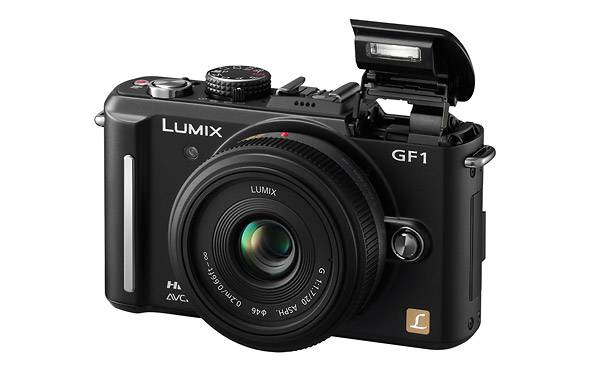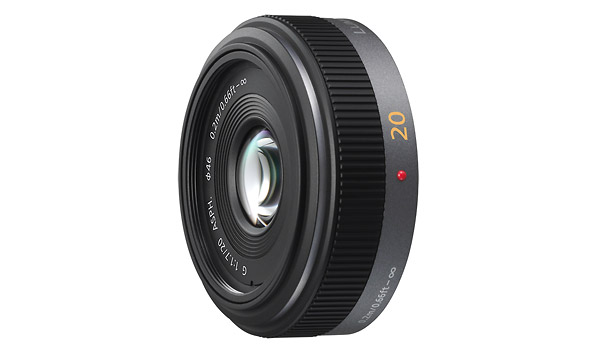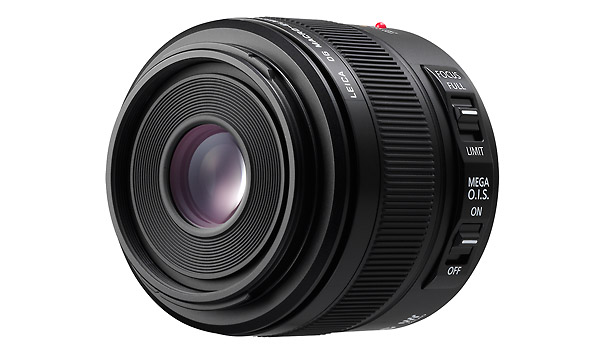 Panasonic has announced their third Micro Four Thirds camera, the Lumix DMC-GF1. Obviously an answer to the well-received Olympus E-P1 Micro Four Thirds camera, the Panasonic Lumix GF1 is about the same size as its Olympus cousin, but adds a built-in pop-up flash and optional electronic viewfinder (EVF). Like previous Micro Four Thirds cameras, the new GF1 uses a 12-megapixel CMOS sensor. And like the Olympus E-P1, it captures HD video at 1280 x 720 (720p) resolution. Along with the GF1, Panasonic is introducing two new Micro Four Thirds lenses, a compact 20mm f/1.7 pancake lens (40mm equivalent) and Leica’s first Micro Four Thirds lens, the DG Macro-Elmarit 45mm f/2.8 ASPH/MEGA O.I.S. (90mm equivalent).
Panasonic has announced their third Micro Four Thirds camera, the Lumix DMC-GF1. Obviously an answer to the well-received Olympus E-P1 Micro Four Thirds camera, the Panasonic Lumix GF1 is about the same size as its Olympus cousin, but adds a built-in pop-up flash and optional electronic viewfinder (EVF). Like previous Micro Four Thirds cameras, the new GF1 uses a 12-megapixel CMOS sensor. And like the Olympus E-P1, it captures HD video at 1280 x 720 (720p) resolution. Along with the GF1, Panasonic is introducing two new Micro Four Thirds lenses, a compact 20mm f/1.7 pancake lens (40mm equivalent) and Leica’s first Micro Four Thirds lens, the DG Macro-Elmarit 45mm f/2.8 ASPH/MEGA O.I.S. (90mm equivalent).
It wouldn’t be right to discuss the Panasonic GF1 without comparing it to the Olympus E-P1. To some extent, they’re like variations of the same Micro Four Thirds dish. The Panasonic GF1 is approximately the same size and weight as the Olympus E-P1 and Panasonic says it has an “elegant, compact design reminiscent of classic film cameras.” The E-P1 camera design was based on the Olympus Pen half-frame 35mm cameras from the sixties. It’s retro styling really struck a chord with photographers and camera lovers. From the wording in their press release, it’s clear that Panasonic would like to hit that same chord. I don’t think they’ve done it, though. The GF1 doesn’t have the same art deco, retro look and feel that the E-P1 has. In fact, the GF1 looks pretty much like a Panasonic Lumix to me.

Panasonic Lumix DMC-GF1 Key Features:
- Compact, light body – 2.80 x 4.69 x 1.43 inches and 0.63 lbs (7.1 x 11.9 x 3.6 cm and 285.8 g)
- Micro Four Thirds lens mount
- 12.1-megapixel Live MOS imaging sensor (same as other Micro Four Thirds cameras)
- ISO 100 to ISO 3200 sensitivity
- 1280 x 720 (720p) HD video capture at 30 FPS in AVCHD Lite or MPEG formats
- Continuous auto focus in video mode
- Contrast auto focus with Tracking AF and 0.3-second reaction time
- Three frames-per-second maximum burst rate (still shooting)
- 3-inch, 460k-dot LCD display
- Panasonic’s iA (Intelligent Auto) mode for video and still photography
- Peripheral Defocus Mode for selecting out-of-focus areas
- Optional Live View Finder (EVF)
- Venus Engine HD for video and still image processing
- Sensor Dust Reduction system
The Olympus E-P1 may be sexier than the GF1, but looks aren’t everything – especially when it comes to cameras. Unless you’re a collector (and I expect more from you), a camera is a tool first and an object of beauty somewhere after that. Looking at features and specs, the Panasonic GF1 gets more interesting. Lack of a flash is one thing that makes potential Olympus E-P1 buyers pause and reconsider, so the built-in flash is huge. It’s also been widely reported that the Panasonic GH1′s auto focus is much quicker than the E-P1′s. I haven’t used the GH1, but my experience with the E-P1 auto focus has been mixed. It works great when conditions are good. But when they’re not, it can be a real problem. So if fast, accurate auto focus is a top priority for you, then the GF1 is likely a better choice than the E-P1. The optional Live View Finder EVF is also interesting. It’s pretty much impossible to pan accurately with just an LCD display so the Live View Finder could make the GF1 a better camera for photographers who shoot some sports or other action.
Another reason to consider the GF1 is Panasonic’s excellent iA Intelligent Auto mode. It combines scene modes, in-camera processing and image stabilization to make high quality video and still images point-and-shoot simple. As a manual exposure shooter, I was very skeptical of the iA mode. But after a solid day of using it with the Panasonic Lumix ZS3 point-and-shoot, I’m convinced. If you’re a manual shooter, the GF1 has all the manual exposure controls you could ask for. But if you aren’t quite ready for manual photography or you just want to let the camera make the decisions for you, the iA mode can be relied on to deliver great results 98% of the time. Panasonic has also added a new shooting mode called Peripheral Defocus Mode. It allows the photographer to indicate which areas of a scene should be sharp and which should be out of focus. This makes getting traditional style portraits or other selective focus photos more intuitive for less experienced photographers.
The Micro Four Thirds format is arguably one of the most creative applications of digital camera technology. It merges some of the best traits of digital SLRs and compact cameras into one tasty little package. The Micro Four Thirds format isn’t actually competing with DSLR cameras – yet. But I’d like to see the new format continue and evolve so it’s good to see new a new camera, lenses and some positive attention. That said, I’m not sure the new Panasonic GF1 is a serious alternative to the Olympus E-P1. Like I said earlier, it’s more like a different flavor of the same dish. With a built-in flash, better auto focus and the optional EVF it should be a better performer. But the Olympus is sexier. There’s something indefinably satisfying about looking at and having the E-P1 in my hands that makes it special. Do the features and performance of the GF1 add up to a better camera? The only way to find out is to use it in the field. I will say this – as much as I enjoy using the E-P1, it’s pretty poor for any kind of action, which makes it more of a point-and-shoot with great image quality than a digital SLR replacement. If the GF1 is an actual performer when it comes to shooting skiing, cycling, etc., then it could quickly replace the E-P1 in my backpack.
The Panasonic Lumix DMC-GF1 will be available in the beginning of October. It will be packaged in two kits, both of which will sell for $899.95. You can have it with the new LUMIX G 20mm/F1.7 ASPH pancake lens. Or you can have it with the LUMIX G VARIO 14-45mm/F3.5-5.6 ASPH/MEGA O.I.S zoom lens. The optional Live View Finder (DMW-LVF1) will be available at the same time for $199.95.
Panasonic Lumix GF1 Press Release >>
Related Content:
Panasonic Digital Camera User Reviews
Four Thirds Camera Forum
Digital Camera Forums
Olympus E-P1 Preview Article And Video
Micro Four Thirds Announcement
Panasonic Digital Cameras Web Site





The physical size is almost identical to the E-P1, and since I far prefer the user interface of the E-P1 it would be interesting to see what [I]else[/I] has changed since the GH-1.
For a start the front control wheel on the GH-1 is now on the back, where the E-P1 has both its control ring and roller. I like that change.
The video button isn’t on the back where I can hit it accidentally with my thumb, a few times I’ve found my GH-1 has a few minutes of random camera waving video courtesy of my stray digit. I think I’d like that but it depends if that top button, too, can be pressed accidentally.
The GH-1 quick menu just isn’t as good as the E-P1 quick menu, and the two are so different that swapping between them is hard. If you were to use the GH-1 and GF-1 then they may be close enough not to confuse the issue.
I’m not sure the GF-1 is different enough to sway me from the E-P1. For me if there was an E-P2 with tilt/swivel higher resolution screen, that would be [I]almost[/I] ideal. Almost because I’m so long sighted as to be unable to use the screen for manual focus, even with my varifocals, regardless of the number of pixels.
I’m also not sure the plug-in EVF will be adequate for my uses, the EVF on the GH-1 certainly isn’t. I shoot action, and I would prefer a plug-in optical finder, with a transmittal LCD to carry the status information normally scattered around the edges of the EVF. Or even four narrow LCDs making a frame around the optical finder.
But starting out from scratch, the GF-1 looks a very strong contender.
Thanks for the article. The GF-1 looks like a nice addition to the M4/3 system. Since I’ve been using the E-P1 for about a month I’ve learned to really enjoy it. One feature that is a deal breaker for me is the IBIS that Olympus put into the E-P1. Now that I have this option, I don’t think I would buy a camera without it. I also like the fact that you can use almost any lens on the E-P1 and utilize the AF and IS (except for manual lenses of course).
I also like the looks/style/body of the E-P1 – and it fits perfectly in my hands. The body of the GF-1 looks like the LX3 to me (which I still have and won’t sell anytime soon). I’m happier with the size, weight and feel of the E-P1. I’m still going through the learning curve, but am finding the IQ comparable to some of my “L” lenses which I never would have expected (in good light, of course).
I’m interested to see some image comparisons – IQ is always the No. 1 consideration with cameras and lenses for me.
Liz
Thanks for the comments, Paul. It’s interesting to see what you think since you’re using both the E-P1 and the GH1. I was all set to pony up for the GH1 for video. But the new Canon EOS 7D threw a wrench in that plan. Not sure what to do about video now. Guess I’ll wait and see how the Canon is, overall.
Note: the vBulletin code doesn’t work in the articles section – gotta use the html for your italics
You said panning with the LCD on the E-P1 was difficult, I agree. It turned out to be virtually impossible.
With the E-P1 when I was first testing at the Zolder 24h, I didn’t get even 1 good night photo and so I didn’t bother getting it out for racing at Chicagoland. I travelled light with micro 4/3 only and used the GH-1 (not a Canon in sight!) for race shots.
I’ve found it pretty difficult to pan a race car with the GH-1 and shoot in burst mode, as the screen goes blank. So I don’t expect the GF-1 to be any better than the GH-1 in that regard.
But because I was holding the camera up to my face instead of at arms length, I could get night racing shots at Chicagoland Speedway with the GH-1 – sighting in the EVF first and then panning at constant rate.
I could usually get the first shot of a burst in frame, and occasionally the second, rarely the third.
It is all down to technique overcoming the camera’s limitations, and something like the Canon G9 with it’s optical finder would be easier to use. But the attraction of the Panasonic 45-200mm lens for the micro four thirds in in the compactness and lightness as well as the longer reach leads me to keep persevering with it.
I don’t expect the EVF on the GF-1 to be much different in performance from the GH-1, it should be usable for action if you’re shooting in good light and taking only one shot. Which, if you want to capture the moment, you probably will be doing anyway.
So as a pocket camera that can take a long lens I think it has a lot of potential,.
But as I’ve already bought the E-P1 I’m not a candidate for changing. Honest. No way will I buy yet another camera. I have the GH-1 for video and the EP-1 for stills. Really … that’s what I’m telling my wife and the bank manager anyhow.
Paul-
Your next assignment is to try the Olympus E-620
Hi
I have the EP-1 and G1. And the two are very different animals both in use and in image quality. I love the G1′s quick AF system which works better than the EP-1. I think the EVF on the G1 is adequate but not perfect but the noise handling on the G1 at ISO 800 and ISO1600 is no where near the capability of the EP-1.
The EP-1 has its merits too. You need a MEGA OIS lens on the G1 to compensate for camera shake while the EP-1 has this built into the body. This feature, regardless on how steady your hands are, is very useful especially when you do a lot of street photography.
The EP-1′s viewfinder is pretty bad, and in bright sunlight, is almost useless. With the G1, you could at least peek into the EVF.
Now, here comes the question, should you upgrade to a GF-1? Well, look at it this way, if you are only planning to use the kit lens, 14-45mm, on the GF-1, then it is a fine buy. Noise handling on this will be similar to that of GH1, which beats the G1. The optional EVF attachment for the GF-1 will go some way to addressing the visibility of the LCD screen in bright sunlight but ti comes with a price.
So how much are you willing to pay for the privilege? USD$1100 for a kit GF-1 with an optional EVF will solve the problems inherent in the EP-1. Whereas the Pen EP-1 will go for USD$800 sans EVF.
As a current user of the G1, I would buy the GF-1 body with the optional EVF. I’ve skipped the GH1 because it was overpriced and the video function just didn’t serve my purpose.
Since the Panasonic GF1 is pretty much like an entry level DSLR, the decision whether to buy the GF1 or the Canon T1i is mostly on portability.
I personally prefer carrying smaller cameras since they’re not in the way when I travel or go out.
Recently I bought the GF-1 with the 20mm panny lens. To me, the GF-1 is pretty much an upgrade from the LX3 (which I also own) but with added more added features and interchangeable lens capabilities. The wonders of the M4/3 mounts is the multiple adaptors which are available in the market for it.
During the purchase of the GF-1, I also got myself a Nikon F mount to M4/3 adaptor. It is the only sensible choice as it is the only lens system which I own as I use the Nikon D200 and the Fuji S5Pro for work. Now with the wide variety lenses which I am able to use on the GF-1, it makes it the most suitable backup camera, as I do not need to bring any extra lenses for it. Now what is in my bag for my travel assignments, is a DSLR body, Nikon primes, and the GF-1.
Thanks for the comment, Richard. Please write a user review for your GF1 and lenses. User reviews are the foundation of this site and we could use your review: Panasonic Lumix GF1 User Reviews >>
I want to add that I think you left out what I think is the most important distinction between the LX3 and the GF1 – image quality. The Micro Four Thirds camera sensor is way bigger than the LX3′s sensor/ So no matter how much people rave about the LX3, it can’t compare to the GF1 or any other Micro Four Thirds camera.